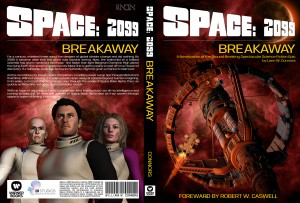Something similar happened to the original Battlestar Galactica, so it does not seem that outlandish to me.
-
Welcome! The TrekBBS is the number one place to chat about Star Trek with like-minded fans.
If you are not already a member then please register an account and join in the discussion!
You are using an out of date browser. It may not display this or other websites correctly.
You should upgrade or use an alternative browser.
You should upgrade or use an alternative browser.
Space 1999 reboot
- Thread starter Drone
- Start date
This is a nice concept that somebody posted earlier. Unfortunately, it is virtually identical to Stargate: Universe.
^Maybe so, but it's better than the original show's concept. And in order for it to fly these days, it would have to be a space station, L5 colony, or nothing's happening-nobody's going to believe that a moon can travel through space these days (the moon should have gone into Earth, not into outer space.)
Last edited:
^Maybe so, but it's better than the original show's concept. And in order for it to fly these days, it would have to be a space station, L5 colony, or nothing's happening-nobody's going to believe that a moon can travel through space these days (the moon should have gone into Earth, not into outer space.)
Oh, I agree that it is probably the better concept.
That's no moon. That's a space station! 

16 years too late people...
^Maybe so, but it's better than the original show's concept. And in order for it to fly these days, it would have to be a space station, L5 colony, or nothing's happening-nobody's going to believe that a moon can travel through space these days (the moon should have gone into Earth, not into outer space.)
There are plenty of shows and movies today with equally absurd science. Heroes, in its original run, got away with claiming a solar eclipse could be seen everywhere on Earth at the same time -- as if the Earth were flat. (And even that wouldn't make it possible, really.) The Flash recently used technobabble about "infrared heat rays and ultraviolet cold rays," even though UV is much hotter than IR.
I mean, seriously, there's a large percentage of Americans today who don't even know the Earth orbits the Sun. The level of scientific ignorance is this country is probably greater today than it was in the 1970s.
And as I said before, Space: 1999 wasn't trying to be plausible science fiction; it was intended as more of a surrealist fantasy, a space-age Odyssey myth. The 2004 Battlestar Galactica succeeded at doing magic realism in outer space, so maybe there's room for surrealist fantasy in space too. And most feature films set in deep space tend to be fantasy anyway -- The Chronicles of Riddick, Jupiter Ascending, that obscure franchise about the wars among the stars, etc.
^Maybe so, but it's better than the original show's concept. And in order for it to fly these days, it would have to be a space station, L5 colony, or nothing's happening-nobody's going to believe that a moon can travel through space these days (the moon should have gone into Earth, not into outer space.)
These days? The moon issue was widely criticized when Space: 1999 premiered. It was that series-defining plot point which led many to write it off as an unlikely "answer" to Star Trek (which was the media conversation about Space:1999 as it was being developed).
^Thanks for the reminder about that. But what was glaringly apparent then will be even so now.
The Flash recently used technobabble about "infrared heat rays and ultraviolet cold rays,"
That bites...
And as I said before, Space: 1999 wasn't trying to be plausible science fiction; it was intended as more of a surrealist fantasy, a space-age Odyssey myth.
True--but it is still fun to speculate. If the standard candles really are standard--then the whole universe is doing what the one Moon did--racing away ever faster.
Maybe the way to go is to make the surrealism and mystery even more overt -- to acknowledge up front that the Moon being propelled through interstellar space makes no sense, but is somehow happening anyway, and that everything we thought we knew about the universe must now be called into question.
Which seems to be where we are in cosmology as it stands.
O/T
One of the things that interested me is the possibility of life in a universe with no weak nuclear force:
https://en.wikipedia.org/wiki/Weakless_Universe
If the Star Wars universe has life with one more Force, this allows life to exist with one less.
http://arxiv.org/abs/hep-ph/0604027
http://www.slac.stanford.edu/cgi-wrap/getdoc/slac-pub-11795.pdf
No neutrinos from supernovae--and nothing radioactive? Maybe a little short on oxygen
http://bama.ua.edu/~lclavell/papers/weakless2c.pdf
I love this concept in that it gives the anthropic principle a punch in the nose--though it might make for a good (junk science) horror story with astronauts returning from this alterverse having been stripped of their souls.
A good Space 1999 episode, no?
Last edited:
Similar threads
- Replies
- 13
- Views
- 5K
- Replies
- 31
- Views
- 2K
- Replies
- 5
- Views
- 709
- Replies
- 5
- Views
- 595
If you are not already a member then please register an account and join in the discussion!

